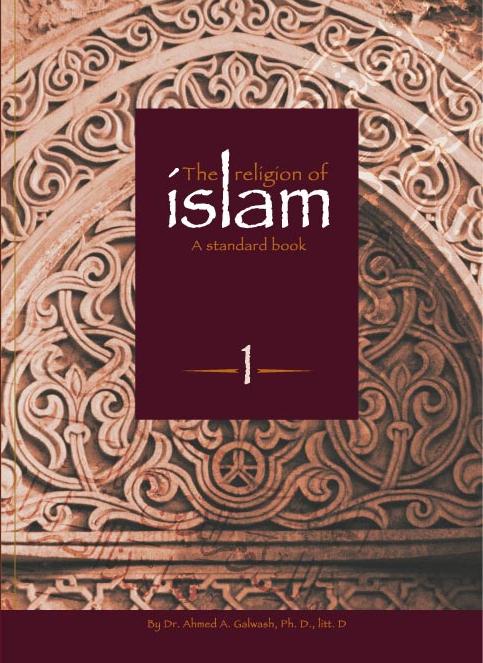The Religion Of Islam vol.1

HISTORY OF THE ARABS
A SUMMARY
Arabia is the great western peninsula of Asia. Its area is about 1,230,000 square miles, i.e. about one third of Europe. The name is said to be derived from “Araba”, a small district in the south east of the province of Tehama, to which Yarab the son of Kahtan (The Biblical “Joktna”), the father of the ancient Arabs gave his name, and where some ages after dwelt Ishmail, the son of Abraham and Hagar.
The chief province in connection with the history of Islam is known as the Hidjaz, which occupies the western strip of Arabia to the east of the Red Sea and contains the famous cities of Mecca and Median. The former of these claims the distinction of being the birth place of the Prophet and possesses the celebrated sanctuary of the Kaaba, and the second was the home of the Prophet for the last ten years of his life, and in it he was laid to rest.
The shrine of Kaaba is stated to have been originally built by Abraham and Ismail for the worship of the true God, but in after times it became the common pantheon of pagan Arabia. The peninsula of Arabia has always been inhabited by two –classes – town dwellers and those who live in tents. The former live by tillage, the cultivation of palm–trees, cattle breeding, and the exercise of trades, and even in the time of Jacob, were famous as merchants. The members of the tribe of Koreish, the wealthiest and most distinguished of the Arabian tribes, were especially engaged in commerce, and Mohammed in his youth was brought up as a trader, as it was the Arabian customs for sons to carry on the business of their fathers. The Arabs who dwelt in tents were occupied with the pasturing of their flocks, varied by the raiding of caravans and pillaging of travelers. They lived chiefly on milk, dates and camel flesh; they changed their habitation as the convenience of water and of pasture required staying no longer in one place when these failed.
Whether townsmen or tent–dwellers, the Arabs have always been divided into tribes and clans, each having its own habits, customs, mental outlook and peculiarities and being more or less distinct from the other in mode of worship, in culture and development. This diversity of culture was mainly due to diversity of origin. Various races had inhabited the peninsula in various ages. Many of these had passed away, but their failure or success to add luster to the Arab race was ever fresh in the memory of successive generations, and on this tradition the early history of the nation was based.
The most famous tribes of the ancient Arab were those of Aad, Thamoud and Amalik. The destruction of the first two tries by God for refusing to acknowledge the missions of his prophets to them or to obey them, is frequently referred to in the Koran as instances of God’s Judgment on obstinate unbelievers and a warning to the Quraishites, the tribe of Muhammad, who were his most powerful and inveterate enemies.
According to tradition, the Adites appeared at one time to have been powerful and conquering people. They are said to have invaded Babylonia 2000 years B.C.[1] The Thamudites were people who lived in houses carved in the rock. The ruins of these habitations are described in Sir Henry Layard’s “Early Travels”. The tribe of Amalik rendered itself so powerful that before the time of the Prophet Joseph it conquered the middle of Lower Egypt and furnished several of her Kings, known to history as the “Shepherd Kings.”[2] After they had possessed the throne of Egypt for some generations, they were expelled by the inhabitants and finally were destroyed utterly by the Israelites.[3]
The Arabs of today are descended from two stocks Kahtan (Biblical Joktan), son of Eber and Adnan, descended in a direct line from Ishmael, the son of Abraham and Hagar. The former are considered as pure Arabs, the latter as naturalized Arabs. The posterity of Ishmael had intermarried and settled among the Kahtanic Arabs and had become amalgamated with them into one nation.
The Arabians were fore some centuries governed by descendants of Kahtan, Yarab one his sons, founding the kingdoms of Yemen in the south and Jorham, another that of Hidjaz in the north.
The descendants of Yarab known as the kings of Himyar continued to reign undisturbed over Yemen until the time of Alexander the Great. The first great calamity that befell the tribes who settled there, was the inundation of Arem which happed about 340 B.C., one of the leading events in the history of Arabia.
Many tribes had to abandon their dwellings on this occasion, and from the scattered tribes rose two other kingdoms, known as Ghassan and Hira. According to the story of the inundation referred to above. Abd Shams, surnamed Saba, one of the famous kings of the tribe of Himyar having built the city of Saba (first named after him and afterwards called Marat), constructed a vast reservoir to store up the water of the mountain torrents for the use of inhabitants in the years of drought. The dam was so firmly built that there seemed no probability of its bursting. The water rose to the height of twenty fathoms and was kept in on every side by masonry so solid that many of the inhabitants of the province had their houses built on its walls. Each family had a certain portion of this water distributed by aqueducts. But at last (according to tradition), God being highly displeased at their great pride and insolence, and resolving to humble and disperse them, caused a mighty flood to break down by night and carry away the whole city, with the neighbouring towns and people.[4]
The tribes which remained in Yemen after this terrible occurrence still continued under the rule of the original princes till about 70 years before the birth of Mohammed, when the King of Ethiopia sent over forces to assist the Christians of Yemen against the cruel persecution of their King Zul Nowas, a bigoted Jew. They attacked him so closely that he forced his horse into the sea, and so lost his life, and the country was then governed by four Ethiopian Princes in turn till Seif Ibn Zi Yazan, of the tribe of Humyar, having obtained assistance from Khosrou Anushirwan, King of Persia, assistance which had been denied him by the Emperor Heraclius, recovered the throne and drove out the Ethiopians, but was himself slain by some of the enemy who had been left behind.
The Persians appointed the succeeding princes till Yemen fell into the hands of the Prophet Mohammed, to whom Bazan, the last of them, submitted embracing Islam at the same time.[5] The kingdom of the Himyarites is said to have lasted 2000 years.
It has already been observed that two kingdoms were founded by those who left their country on account of the inundation of Arem. They were neither from Arabia properly so called. One was the kingdom of Ghassan. The founders of this kingdom were of the tribe of Azd, settled in Syria Damascena, near a spring called Ghassan, whence they took their name. This kingdom, according to Abulfeda, lasted 600 years, until the Khalifa Omar subjugated the whole of Syria to the rule of Islam.
The other kingdom was that of Hira which was founded in Chaldea of Iraq. This kingdom was better known as the kingdom of Mondhirs of the tribe of Lakhm. These princes retained their throne (except for a short period during which the Persians held the reins of government) till the time of the Khalifa, Abu Bakr, when al Mondhir el Maghrour, the last of them, lost his throne and lufe in battle with Khaled Ibn el Waled the Muslim conqueror of Syria. This kingdom lasted 620 years.
The kingdom of Hidjaz as already observed was founded by Jorham, the son of Kahtan, and remained in the hands of this family until the time of Ismael. The latter married the daughter of Modar, one of the Jorhamite kings, and she bore him twelve sons, one of whom, Kidar by name, inherited the crown from his uncle. The descendants of Kidar expelled the Jorhamite tribe who, retiring to Johainah, was after various fortunes at last destroyed by an inundation.[6] Finally the government of Hidjaz was shared by the heads of tribes almost in the same way as the Arabs of the desert are governed at present.
Mecca was in the hands of an aristocracy that controlled affairs of state until the time of the Prophet Mohammed, to whose tribe the custody of the famous pantheon of Kaaba was transferred.
Thus have the Arabs preserved their liberty and independence, of which few nations can show so glorious and unbroken a record, even from the very Deluge; for though great armies have been sent against them, all attempts to subdue them have failed.
Neither the Assyrian nor the Median Empires ever found a footing in Arabia, and the Persian rulers never succeeded in making her tributary and were so far from being her masters that Combyses, on his expedition against Egypt, was obliged to ask permission to pass through her territories.
When Alexander the Great conquered Egypt, the Arabians held him in so little awe that alone of all the neighbouring nations, sent no ambassadors to him at any time. This want of respect and the desire of possessing so rich a country, made him form a design against it, and had he not died before he could put it into execution, this people might possible have convinced him that he was not invincible.[7]
([1]) George Sale’s translation of the Koran, preliminary Discourse.
